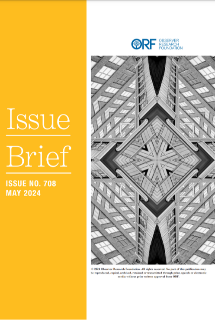
5G technology has emerged as the beacon of innovation, promising unprecedented speed, reliability, and connectivity. It ushers in a new era of digital connectivity across various sectors, including healthcare, infrastructure, and education. China is a prominent player in the global 5G market, spearheading its Digital Silk Road (DSR) initiative to export this technology globally. This has raised concerns about China's dominance in this rapidly growing field and therefore it is essential to explore adaptable and scalable solutions. Open Radio Access Network (O-RAN) has emerged as a disruptive alternative, challenging traditional approaches. O-RAN essentially “opens the protocols and interfaces between these various building blocks (radios, hardware, and software)” in traditional Radio Access Networks—a major component of a wireless telecommunications system. This strategic shift towards separating hardware and software components can lead to more balanced and sustainable technology ecosystems.
O-RAN essentially “opens the protocols and interfaces between these various building blocks (radios, hardware, and software)” in traditional Radio Access Networks—a major component of a wireless telecommunications system.
Building blocks of connectivity
Traditionally, telecommunications infrastructure has been dominated by proprietary hardware and software solutions, tightly integrated into monolithic architectures. This approach, while effective, often leads to vendor lock-in, limited flexibility, and high deployment costs. Unlike traditional networks where hardware and software are tightly integrated, O-RAN brings disaggregation, allowing interoperability among different vendors' equipment, which enables greater flexibility, innovation, and resilience in the network architecture. This modular architecture allows operators to mix and match components, optimise performance, and deploy networks more efficiently. At its core, O-RAN comprises three key elements: the Radio Unit (RU), Distributed Unit (DU), and Centralised Unit (CU).
Table 1: O-RAN elements explained
| Radio Unit (RU) |
Distributed Unit (DU) |
Centralised United (CU) |
| ● Radio Transmission and reception ● Software ● Same provider |
● Baseband processing and network orchestration ● Hardware ● Could have different providers |
● Baseband processing and network orchestration ● Hardware ● Could have different providers |
Source: Nokia
It is important to note that O-RAN and 5G are not competing technologies but rather complementary frameworks. While 5G refers to the next generation of mobile networks, promising unprecedented speed, capacity, and connectivity, O-RAN focuses on the infrastructure supporting these advancements. In essence, O-RAN is an enabler for 5G, providing the flexible and scalable architecture necessary to realise its full potential. By decoupling hardware and software, O-RAN facilitates the rapid deployment of 5G networks, accelerates innovation cycles, and reduces dependency on specific vendors. Moreover, O-RAN extends beyond 5G, offering benefits across different generations of mobile technology. Its principles of openness pave the way for future advancements, ensuring that networks remain adaptable and resilient in the face of evolving requirements.
Taming the Dragon?
5G networks use cloud technology that helps “simplify mobility, with seamless open roaming capabilities between cellular and Wi-Fi access”. They are predominantly provided by Chinese companies, such as Huawei and ZTE, which lead the charge in 5G infrastructure deployment. Through a subsect of China’s Belt and Road Initiative, the Digital Silk Route, the export of telecom equipment has increased Huawei’s global share by 40 percent. In Africa, it has built 70 percent of the networks, raising concerns regarding security vulnerabilities and geopolitical influence. To counter China’s monopoly, many countries such as Australia, Japan, the United Kingdom (UK), and the United States (US) banned Huawei’s operations, with India phasing out the use of Huawei’s equipment in its 5G rollout. The fear of a single point of failure and potential data breaches looms large, prompting a quest for alternative solutions.
To counter China’s monopoly, many countries such as Australia, Japan, the United Kingdom (UK), and the United States (US) banned Huawei’s operations, with India phasing out the use of Huawei’s equipment in its 5G rollout.
In light of these concerns, the development of O-RAN may be seen as a response to the need for newer frameworks. By breaking free from vendor lock-in and fostering a competitive ecosystem, O-RAN could offer a path towards democratising access to 5G technology and mitigating concerns surrounding Chinese dominance. Many nations are investing in the research and development of O-RAN, recognising its potential to reshape the telecommunications landscape.
Global trends
India, with its vast and rapidly growing mobile subscriber base, recognises the strategic importance of O-RAN in modernising telecommunications infrastructure and expanding connectivity. Leading telecom operators such as Reliance Jio and Bharti Airtel have been exploring O-RAN solutions to optimise network performance and meet the evolving demands of consumers and businesses. Moreover, initiatives like the Telecom Regulatory Authority of India's consultation on promoting indigenous telecom equipment manufacturing align with the broader goal of fostering O-RAN innovation and self-reliance in the telecommunications ecosystem.
In 2023, India and the US established a joint task force through a public-private partnership to develop O-RAN. Recognising the strategic importance of countering Chinese dominance in 5G, the QUAD nations—US, India, Japan, and Australia—announced a new cooperation initiative focused on O-RAN in May 2023. By investing in O-RAN infrastructure among member countries, the QUAD aims to bolster resilience and security in the face of emerging threats. They released an O-RAN Security Report that analysed the advantages, disadvantages, and challenges of O-RAN compared to a traditional RAN and concluded that the “use of O-RAN does not fundamentally alter the security risk landscape for telecommunications, compared to traditional RAN”. This report can be used to further investment and understand O-RAN’s effectiveness as an alternative to 5G. To further O-RAN’s global reach, the Quad is investing in Palau, through which it aims to strengthen digital connectivity in the South Pacific while reducing dependence on Chinese telecom equipment. Other investments in O-RAN are specified in Table 2.
Table 2: Global O-RAN Initiatives
| Country |
Department/Company |
Goal |
| Germany |
Deutsche Telekom and Vodafone |
To invest in research labs and collaborate with industry partners and academia to advance O-RAN standards and technologies |
| Japan |
Rakuten Mobile |
To capitalise on virtualisation and cloud-native technologies to enhance efficiency and scalability |
| South Korea |
SK Telecom and KT Corporation |
To conduct trials and pilot projects to evaluate the feasibility and benefits of O-RAN deployment |
| United Kingdom |
British Telecom Group and O2 (Telefonica UK) |
To collaborate with technology partners to pilot solutions and demonstrate their potential to enhance network efficiency and service quality |
| Government- Department for Digital, Culture, Media and Sport |
To diversify the telecommunications supply chain |
| United States |
Multiple Companies- O-RAN Policy Coalition |
To advocate for policies conducive to O-RAN adoption, and to promote competition and innovation. |
| Worldwide |
Multiple companies, vendors, and research institutions- ORAN Alliance |
To drive innovation and competitiveness in the telecommunications sector at both national and regional levels through research programs. |
O-RAN heralds a transformative shift in the digital connectivity landscape. Its potential to reshape connectivity stems from its fundamental principle: Decoupling hardware and software components of traditional systems. By untethering these traditionally integrated elements, O-RAN introduces flexibility and interoperability, paving the way for innovation and efficiency. This newfound agility empowers network operators to mix and match components from various vendors, fostering a competitive ecosystem where best-of-breed solutions can thrive. Consequently, barriers to entry for new players are lowered, stimulating market diversity and driving down costs. O-RAN's standards-based approach encourages collaboration and compatibility across the industry, facilitating rapid deployment and scalability.
O-RAN democratises access to advanced connectivity technologies by promoting openness and standardisation, potentially bridging the digital divide and bringing reliable internet access to underserved communities.
Beyond mere cost savings, the implications of O-RAN extend to enhancing network resilience and security, as its disaggregated architecture enables easier identification and mitigation of vulnerabilities. O-RAN democratises access to advanced connectivity technologies by promoting openness and standardisation, potentially bridging the digital divide and bringing reliable internet access to underserved communities. As telecommunications infrastructures undergo this profound evolution, stakeholders across industries stand to benefit from the increased innovation, efficiency, and inclusivity facilitated by O-RAN, ultimately shaping a more connected and equitable digital future.
Leveling the connectivity field
The rise of O-RAN carries significant implications for the future of digital connectivity and geopolitics. By fostering a diverse ecosystem of vendors and promoting interoperability, O-RAN has the potential to enhance competition, spur innovation, and safeguard against China’s dominance in 5G. The quest for innovative solutions that foster resilience, security, and democratisation remains paramount as the digital realm continues to burgeon. With concerted efforts from nations across the globe, exemplified by initiatives such as the QUAD's collaboration, O-RAN embodies the epitome of collaborative innovation. As the world strides forward into the era of digital connectivity, O-RAN serves as a beacon of possibility, reshaping the landscape and ushering in a new era of connectivity for generations to come.
Tanya Aggarwal is a Research Intern at the Observer Research Foundation
The views expressed above belong to the author(s). ORF research and analyses now available on Telegram! Click here to access our curated content — blogs, longforms and interviews.




 PREV
PREV


